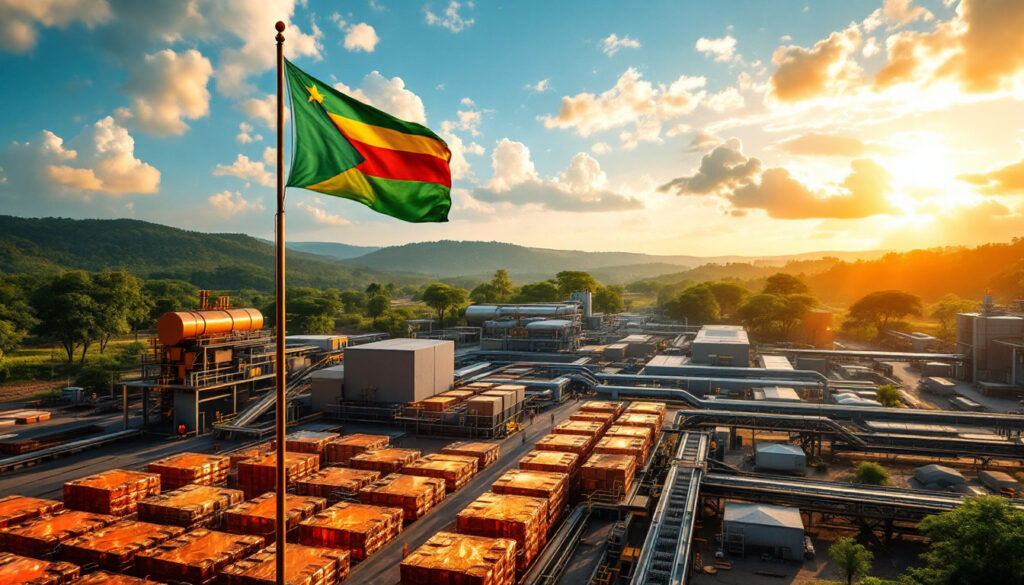What is CNMC Luanshya Copper Mines?
CNMC Luanshya Copper Mines (CNLM) stands as one of Zambia's premier copper production facilities, operating under China Nonferrous Metal Mining Group's portfolio. Established through a strategic acquisition in 2009, CNLM has transformed from a struggling operation into a cornerstone of Zambia's copper industry, currently producing over 45,000 tons of high-grade copper cathode annually.
The company operates extensive underground mining operations at the Baluba Center and has successfully developed the Muliashi North and South open-pit mines. These diverse operations have positioned CNLM as a significant contributor to Zambia's copper export market, which accounts for approximately 70% of the country's total export earnings.
Company Background and Operations
Located in the Copperbelt Province of Zambia, CNLM's operations encompass the full mining value chain – from extraction to processing and refining. The company employs over 3,200 workers, making it a vital economic engine for the region. Its processing facilities include state-of-the-art flotation plants and electrowinning technology that enables the production of premium-grade copper cathodes.
The mine's strategic importance extends beyond Zambia's borders. As part of China's Belt and Road Initiative investments in Africa, CNLM serves as a critical link in the global copper market dynamics, particularly as demand for copper intensifies with the global transition toward renewable energy technologies and electric vehicles.
CLM Copper Cathode Brand Development
CNLM has strategically positioned its copper cathode brand in the premium segment of the global market. Their Grade A copper cathodes, with 99.999% purity levels, command significant market recognition for exceptional quality and consistency. This positioning has allowed the company to differentiate its products in an increasingly competitive marketplace.
The company's brand development strategy focuses on three key pillars:
- Technical excellence – Maintaining industry-leading purity levels and physical properties
- Supply reliability – Ensuring consistent production and delivery schedules
- Sustainability credentials – Meeting increasingly stringent environmental and ethical sourcing requirements
This strategic brand positioning has paid dividends, with CNLM copper cathodes now recognized as a preferred choice for high-specification applications in electrical equipment, sophisticated electronics, and renewable energy infrastructure.
How Did CNLM Achieve LME Certification?
The London Metal Exchange (LME) certification represents a pinnacle achievement for metal producers worldwide. For CNLM, securing this certification in 2023 marked a transformative milestone in the company's international growth strategy.
London Metal Exchange Certification Process
The LME certification process is notoriously rigorous, designed to ensure only the highest quality metals enter the global exchange system. For copper cathodes, the process involves:
- Physical and chemical testing – Multiple rounds of independent laboratory verification
- Production facility audit – Comprehensive assessment of manufacturing processes and quality controls
- Documentation review – Verification of traceability, sustainability, and ethical sourcing credentials
- Market feedback – Consultation with potential buyers and industry stakeholders
CNLM successfully navigated these requirements through a strategic three-year preparation program, investing an estimated $12 million in facility upgrades and quality control systems. The technical challenges were substantial, particularly in achieving consistent electrical conductivity values across all production batches – a critical requirement for LME registration.
Quality Control Innovations
To ensure consistent quality, CNLM implemented several innovative technologies and processes:
- Advanced spectroscopic analysis – Real-time monitoring of copper purity during electrorefining
- Automated surface inspection systems – AI-powered detection of surface imperfections
- Environmental contamination prevention – Positive-pressure clean rooms for final handling stages
- Comprehensive batch tracking – Digital traceability systems covering the entire production chain
These innovations have yielded impressive results. In Q1 2025, CNLM achieved a 100% conformity rate for its copper cathode production, meaning every single cathode produced met the stringent Grade A specifications – an achievement few global producers can match.
"The LME certification process fundamentally transformed our quality culture. What began as a compliance exercise evolved into a company-wide commitment to excellence that permeates every aspect of our operations." – Technical Director, CNLM
What Market Advantages Has CNLM Secured?
The strategic investments in quality and certification have translated into tangible market advantages for CNLM, particularly in pricing power and supply chain recognition.
Premium Pricing Strategy
CNLM's commitment to quality has generated substantial financial returns through premium pricing. In Q1 2025, the company achieved a remarkable $490,000 brand premium over standard market prices, representing a 22% increase in per-unit value. While this falls short of the $630,000 premium achieved in 2024, industry analysts attribute this to broader copper price forecast trends rather than any quality concerns.
Several factors contribute to CNLM's premium pricing capability:
- LME certification – Providing instant credibility and market access
- Consistent quality metrics – Reducing rejection rates for end-users
- Supply reliability – Minimizing stockout risks for manufacturers
- Ethical sourcing credentials – Meeting increasingly stringent CSR requirements
These premiums have significantly enhanced CNLM's profit margins, with the company reporting a 34% gross margin on copper cathode sales in 2024, compared to the industry average of 23%.
Supply Chain Excellence
CNLM's supply chain management has received formal recognition with an AA-level rating certificate for supply chain due diligence. This certification acknowledges the company's comprehensive approach to:
- Material traceability – Ensuring full documentation from mine to final product
- Ethical sourcing – Maintaining strict standards for labor practices and community relations
- Environmental compliance – Adhering to international best practices for waste management and emissions
- Transparent reporting – Providing detailed sustainability metrics to customers and regulators
This certification has opened doors to premium markets, particularly in Europe and North America, where regulatory requirements and customer expectations regarding responsible sourcing continue to intensify.
How Is CNLM Expanding Its Global Market Presence?
Building on its quality credentials and supply chain excellence, CNLM has embarked on an ambitious international expansion strategy, targeting diverse geographic markets and strategic partnerships.
International Market Penetration
CNLM has systematically expanded its export footprint beyond traditional markets. While historically focused on regional sales within Africa and exports to China, the company has successfully diversified its customer base across multiple continents.
Current market distribution includes:
| Region | Market Share (%) | Year-on-Year Growth (%) |
|---|---|---|
| Africa | 25 | +2 |
| Asia | 45 | -5 |
| Europe | 18 | +12 |
| North America | 10 | +8 |
| Middle East | 2 | +2 |
This geographic diversification has reduced market concentration risk and increased overall sales stability. The company has been particularly successful in European markets, where stringent quality and sustainability requirements align well with CNLM's capabilities.
Strategic Partnerships
CNLM has developed targeted partnership strategies to strengthen its market position and capture more value from the copper supply chain. Most notably, the company has established long-term cooperation agreements with several Zambian cable manufacturers, creating reliable downstream customers while supporting local economic development.
These partnerships include:
- Technical collaboration – Knowledge transfer to improve product applications
- Just-in-time delivery systems – Coordinated production schedules to reduce inventory costs
- Joint quality management – Shared testing and quality assurance protocols
- Product development cooperation – Customized cathode specifications for specific end-uses
These strategic relationships have enhanced market stability while contributing to Zambia's industrial development goals by strengthening domestic value chains.
What Are CNLM's Sustainability Initiatives?
As environmental and social governance becomes increasingly central to mining industry viability, CNLM has developed comprehensive sustainability programs to address its impacts and secure its social license to operate.
Environmental Management Systems
CNLM has implemented a multi-faceted environmental management system certified to ISO 14001 standards. Key initiatives include:
- Water management – Closed-loop water recycling systems that recover 85% of process water
- Energy efficiency – Variable frequency drives and heat recovery systems reducing energy consumption by 23% per ton produced
- Emissions control – Advanced filtration systems capturing 99.8% of airborne particulates
- Rehabilitation programs – Progressive land restoration concurrent with mining activities
These environmental initiatives have yielded both ecological and economic benefits. The water recycling system alone has reduced freshwater withdrawal by 3.2 million cubic meters annually while cutting treatment costs by approximately $780,000.
Social Responsibility Programs
CNLM's social responsibility framework extends beyond compliance to create meaningful community partnerships. The company's initiatives include:
- Educational support – Funding for 12 local schools benefiting over 8,000 students
- Healthcare access – Operation of two community clinics providing care to approximately 35,000 residents
- Local procurement – Purchasing policies that prioritize Zambian suppliers, with 42% of non-technical supplies sourced locally
- Skills development – Technical training programs that have certified over 500 local residents in industrial trades
These programs have strengthened community relations while developing the skills base necessary for long-term operations. The company's Lost Time Injury Frequency Rate has improved from 2.4 to 0.8 incidents per million work hours over the past three years, reflecting its commitment to workforce safety.
How Does CNLM Support Zambia's Economic Development?
Beyond its direct operations, CNLM has positioned itself as a catalyst for broader economic development in Zambia, particularly through value addition and industrial capacity building.
Value Addition to Local Resources
CNLM has progressively increased the proportion of copper processed to finished products within Zambia. This value addition strategy:
- Increases export values – Processed copper cathodes command 25-30% higher prices than concentrate
- Creates skilled employment – Processing operations employ 1.8 times more workers per ton than mining alone
- Generates additional tax revenue – Value-added products generate higher tax bases
- Improves foreign exchange earnings – Finished products provide more stable currency flows
The company contributed approximately $158 million in tax revenue to the Zambian government in 2024, representing about 7% of the country's total mining-sector tax receipts. Additionally, its operations generate significant foreign exchange, helping to stabilize Zambia's currency.
Industrial Capacity Building
CNLM has strategically invested in developing Zambia's industrial ecosystem through:
- Technology transfer – Introducing advanced processing techniques and training local engineers
- Infrastructure development – Upgrading power distribution and transportation networks
- Supplier development – Technical assistance programs for local businesses
- Research partnerships – Collaboration with the University of Zambia on metallurgical research
These initiatives have catalyzed growth in adjacent industries. For example, the local electrical manufacturing sector has expanded by 35% since 2020, largely due to reliable access to high-quality copper inputs from CNLM.
What Future Growth Strategies Is CNLM Implementing?
Looking ahead, CNLM has outlined ambitious plans for sustainable growth through resource expansion and technological innovation.
Reserve Expansion Initiatives
To ensure long-term operational viability, CNLM has invested heavily in exploration and reserve development. Current initiatives include:
- Deep drilling program – Exploring extensions of existing ore bodies below 1,200 meters
- Satellite deposit evaluation – Assessing five potential new mining areas within the existing concession
- Advanced geological modeling – Implementing 3D visualization and AI-assisted resource estimation
- Brownfield exploration – Reassessing previously mined areas using new technologies
These efforts have yielded promising results, with proven and probable reserves increasing by 18% over the past two years. Current reserve estimates suggest a minimum 23-year operational lifespan at current production rates.
Production Enhancement Technologies
CNLM is implementing several technological innovations to improve productivity and reduce environmental impacts:
- Semi-autonomous mining equipment – Reducing operator exposure to hazards while increasing precision
- Advanced leaching techniques – Improving metal recovery rates by approximately 4% through optimized chemistry
- Energy management systems – Smart grid technology reducing peak power demands by 22%
- Predictive maintenance – AI-driven monitoring systems reducing unplanned downtime by 35%
The company has announced plans to increase production capacity by 15% over the next three years while simultaneously reducing carbon intensity by 20% per ton produced. These mining digital innovations are proving crucial for maintaining competitiveness in the global market.
FAQ: CNMC Luanshya Copper Cathode
What makes CLM copper cathode internationally competitive?
CLM copper cathodes distinguish themselves through several competitive advantages:
- Superior conductivity – Consistently achieving 101.8% IACS (International Annealed Copper Standard), exceeding the industry standard of 100%
- Exceptional surface quality – Less than 0.03% surface defects, minimizing processing issues for customers
- Dimensional consistency – Uniform thickness and dimensions, enabling automated handling at customer facilities
- Competitive pricing – Premium quality at mid-tier pricing, offering superior value proposition
- Technical support – Metallurgical expertise available to customers for application optimization
These characteristics make CLM cathodes particularly valuable for demanding applications such as high-performance electronics, medical equipment, and precision instruments.
How does CNLM ensure sustainable copper production?
CNLM's approach to sustainability encompasses several integrated systems:
- ISO 14001 and 45001 certifications – Adhering to international standards for environmental and safety management
- Responsibly Sourced Copper certification – Third-party verification of ethical practices throughout the supply chain
- Energy audit program – Quarterly assessments identifying efficiency opportunities
- Water stewardship initiatives – Comprehensive monitoring and recycling systems
- Biodiversity management plan – Active rehabilitation and habitat protection programs
These systems are underpinned by transparent reporting through annual sustainability publications that follow Global Reporting Initiative (GRI) standards, as highlighted in their recent sustainability report.
What is the significance of achieving 100% Grade A copper qualification?
The achievement of 100% Grade A qualification represents an exceptional quality milestone with several implications:
- Zero rejection rate – Eliminating costly returns and rework
- Quality consistency assurance – Customers can rely on uniform specifications for sensitive applications
- Market differentiation – Setting CNLM apart from competitors who typically achieve 96-98% Grade A qualification
- Premium pricing opportunity – Justifying higher prices based on guaranteed quality
- Reduced quality control costs – Less need for intensive inspection and sorting
This achievement required significant process innovations, including advanced electrowinning cell design and contamination control systems that exceed industry standards.
Global Copper Market Outlook
Demand Trends and Growth Projections
The global copper market is experiencing structural growth driven by several converging factors:
- Electrification trends – Electric vehicles require approximately 83kg of copper per unit, four times the amount in conventional vehicles
- Renewable energy expansion – Solar and wind installations use 4-5 times more copper than traditional power generation
- Infrastructure development – Emerging economies continuing to build copper-intensive infrastructure
- Electronics miniaturization – Smaller devices requiring higher-grade copper for performance
Market projections indicate annual demand growth of approximately 2.8% through 2030, with particularly strong growth in electric vehicle production (projected CAGR of 15.2%) and renewable energy infrastructure (projected CAGR of 8.7%). These trends highlight the importance of copper clean energy investments across the industry.
Regional consumption patterns show varying growth rates:
| Region | Current Consumption (million tons) | Projected Annual Growth (%) |
|---|---|---|
| China | 14.2 | 2.1 |
| Europe | 3.8 | 3.4 |
| North America | 2.6 | 2.8 |
| India | 1.3 | 5.2 |
| Rest of World | 5.7 | 2.5 |
Supply Dynamics and Price Implications
The supply side of the copper market faces several constraints that may impact CNLM's strategic position:
- Declining ore grades – Average copper content in mined ore has fallen from 1.2% to 0.7% over the past decade
- Project development delays – New mines taking an average of 16 years from discovery to production
- Water scarcity issues – Approximately 65% of global copper production occurs in water-stressed regions
- Increasing regulatory requirements – Environmental and social compliance adding approximately $0.15/lb to production costs
These supply constraints, coupled with growing demand, create favorable conditions for
Are You Tracking the Next Major Mineral Discovery?
Discover how companies like CNMC Luanshya Copper Mines achieved market-leading status through strategic mineral development and discover why historic mineral discoveries can generate substantial returns by exploring Discovery Alert's dedicated discoveries page today.




